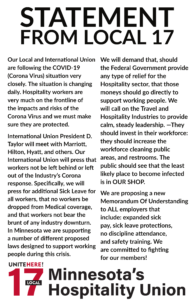What is Coronavirus (COVID-19)?
Coronavirus 2019 (COVID-19) is a pneumonia of unknown cause first detected in Wuhan, China.
What are the symptoms of COVID-19?
Fever
Cough
Shortness of breath
How does COVID-19 spread ?
Spread person-to-person between close contacts (within 6 feet) through droplets that spread in the air when an infected person coughs or sneezes
What are other possible ways that COVID-19 may spread?
Per the CDC, limited possibility of disease spread by coming in contact with people before they show symptoms and/or possibly by touching a surface/object that has the virus on it and then touching one’s mouth, nose, or eyes.
What should your employer do to keep you safe?
Provide employees updated information on staying safe from coronavirus at work
Classify worker exposure to COVID-19. Tell you which job tasks may put you at risk for exposure to sources of infection & train you on safe work practices specific to the risk associated with your job tasks.
Per OSHA’s Guidance on Preparing Workplaces for COVID-19, basic steps employers can take include:
Develop an Infectious Disease Preparedness & Response Plan; Prepare to Start Basic Infection Prevention Measures.
Provide & train you on proper use of personal protective equipment (PPE).
Train you on cleaning & disinfecting procedures and safe use of chemicals.
Promote safe work practices: require regular hand washing; provide soap & water. If not available, hand sanitizer.
Provide a workplace free from retaliation against employees for using their OSHA rights1 (OSHA Section 11c).
Employer Responsibilities: OSHA recommends these standards for controlling COVID-19 hazards at work:
OSHA 1910 Subpart 1 – Personal Protective Equipment (PPE) requiring gloves (OSHA 1910.138), eye and face protection (OSHA 1910.133), and respiratory protection (OSHA 1910.134).
OSHA 1910.1030 Bloodborne Pathogens covering blood, bodily fluids & respiratory secretions.
OSHA 1910.1200 Hazard Communication covers hazardous chemicals used for cleaning & disinfection.
OSHA 1910.141 Sanitation requires employers to provide soap & water.
OSHA General Duty Clause Section 5(a)(1) requires employers provide “…a place of employment, which are free from recognized hazards that are causing or are likely to cause death or serious physical harm.”
Cal/OSHA 5199 Aerosol Transmissible Diseases to prevent infectious diseases that can be transmitted by inhaling air containing viruses; it is only mandatory for certain healthcare employers in California.
What are daily preventive actions?
Avoid close contact with people who are sick.
Avoid touching your eyes, nose, and mouth.
Cover mouth & nose with a tissue when you cough or sneeze. Throw tissue in the trash.
WASH YOUR HANDS OFTEN with soap & water for at least 20 seconds.
Use a 60% alcohol-based hand sanitizer, if soap and water are not available.
Clean and disinfect frequently touched objects and surfaces.
If you feel safer by changing out of your work clothes before going home, then do so.
1. The Occupational Safety and Health Administration (OSHA) was created to ensure safe and healthful working conditions for workers by setting and enforcing standards and by providing training, outreach, education and assistance. https://www.osha.gov/aboutosha
